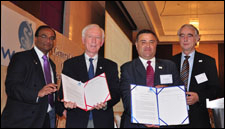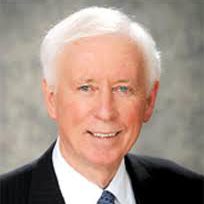One Health Initiative: WMA and WVA
At the World Medical Association (WMA) General Assembly meeting in Bangkok last month the WMA and World Veterinary Association (WVA) signed a Memorandum of Understanding (MOU) to “…collaborate in the One-Health Initiative which is a unified approach to veterinary and human medicine (veterinarians and physicians) in order to improve Global Health”.

The One Health Initiative is a movement to forge co-equal, all-inclusive collaborations between physicians, osteopaths, veterinarians dentists, nurses and other scientific-health and environmentally related disciplines.
Recognizing that human health, animal health and ecosystem health are inextricably linked, One Health seeks to promote, improve, and defend the health and well-being of all species by enhancing cooperation and collaboration between physicians, veterinarians, other scientific health and environmental professionals and by promoting strengths in leadership and management to achieve these goals.
Work on the MOU began earlier this year and participation by the WMA is consistent with established policy to work collaboratively with the World Veterinary Association. Present at the meeting for the ceremonial signing on behalf of the WVA were Dr. Faouzi Kechrid, President and Dr. Tjeerd Jorna, Past President.
The scope of cooperation proposed by the MOU will include:
- Support the concept of joint educational efforts between human medical and veterinary medical schools;
- Support cross species disease surveillance and control efforts in order to prevent zoonotic diseases;
- Collaborate in the responsible use of antimicrobials with respect to critical antimicrobial lists for humans and animals;
- Enhance collaboration between human and veterinary medical professions in medical education, clinical care, public health and biomedical research.
While physicians have a lot in common with veterinarians, there are, of course, differences. A vet’s patients for example can’t cay where they hurt, or describe their symptoms. Or helpfully “diagnose” themselves.
However, in the realm of medicine and public health cooperation between these fields has never been more urgent. Of the nearly 1,500 diseases now recognized in humans 60 per cent are caused by pathogens that affect multiple animal species.
And about three of every four newly emerging human infectious diseases originate in animals. This includes terrifying conditions such as Ebola, Lassa Fever, and the Nipah, Hendra and Marburg viruses.
And the threat is not confined to exotic microbes. Poor environmental health affects human and animal health in other ways, through pollution, contamination and conditions conducive to the emergence and survival of new infectious agents.
Veterinary medicine is tied to human medicine on other fronts. Many drugs and most medical devices are tested and refined in animal models before use in humans. This is especially important in the pre-clinical testing of implantable devices.
In addition, animals develop many of the same diseases as humans, and are natural laboratories to investigate the efficacy of drugs to fight cancer and other diseases in humans.
Humans, animals, and the environment also intersect at farms, slaughterhouses and processors. How we produce meat and dairy products has a profound impact on the environment and human welfare.
Detection of pathogens in various species is vital to tracking and controlling outbreaks among humans.
And given the rise of antibiotic resistance, what is needed is a more holistic approach and a better understanding of resistance related to use of antibiotic drugs to fight these new contagions.
Sir William Osler, founder of the modern medical teaching concept, embraced the concept that human health and animal health were inextricably linked.
He and one of his veterinary students organized a study of pork and concluded, correctly, that thorough cooking of pork was the best protection against humans contracting parasitic illnesses when ingesting this meat.
This concept of one medicine is so important that the US Centers for Disease Control and Prevention (CDC) has veterinarians on staff as part of the National Center for Zoonotic, Vector-Born and Enteric Diseases.
St. Francis of Assisi said, “If you have men who will exclude any of God’s creatures from the shelter of compassion and pity, you have men who will deal likewise with their fellow men.”
That is what binds us together – veterinarians and medical doctors.
A passion for healing and compassion for the sick.
A call to ease pain and to prevent it.
In his bestseller “The Tao of Pooh” which explored the lessons found in the children’s classic Winnie the Pooh, author Benjamin Hoff said “Lots of people talk to animals. Not very many listen, though. That’s the problem.”
But when veterinarians talk to animals, they do listen. And learn. And share that knowledge.
That is important for the health of us all. As practioners of the medical arts and sciences, we are in a unique position to cooperate to combat illnesses —- and to prevent them in the first place.
And this is true whether our patients talk or bark, moo and oink, purr …. Or whinny.
In the end, we all want what’s best for them.
And, we all share this planet.
My thanks go to Drs. Kechrid and Jorna and the WVA for constructive involvement and leadership in this important joint effort.
* Full MOU can be found at here.

